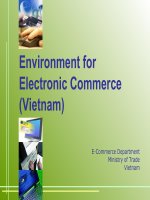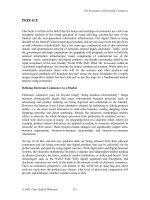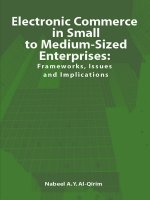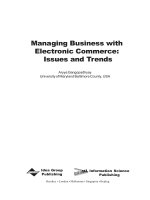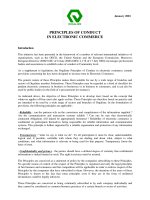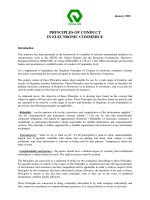Electronic commerce fundamentals ch5
Bạn đang xem bản rút gọn của tài liệu. Xem và tải ngay bản đầy đủ của tài liệu tại đây (738.47 KB, 39 trang )
Chapter 5
5
Security Threats to
Electronic Commerce
Electronic Commerce
1
Objectives
Important computer and electronic
commerce security terms
◆ Why secrecy, integrity, and necessity
are three parts of any security program
◆ The roles of copyright and intellectual
property and their importance in any
study of electronic commerce
◆
5
2
Objectives
Threats and counter measures to eliminate
or reduce threats
◆ Specific threats to client machines, Web
servers, and commerce servers
◆ Enhance security in back office products,
such as database servers
◆ How security protocols plug security holes
◆ Roles encryption and certificates play
◆
5
3
Security Overview
◆
Many fears to overcome
● Intercepted
e-mail messages
● Unauthorized access to digital intelligence
● Credit card information falling into the
wrong hands
5
◆
Two types of computer security
● Physical
- protection of tangible objects
● Logical - protection of non-physical objects
4
Security Overview
Figure 5-1
◆
5
Countermeasures are procedures,
either physical or logical, that
recognize, reduce, or eliminate a threat
5
Computer Security Classification
◆
Secrecy
● Protecting
5
against unauthorized data
disclosure and ensuring the authenticity of
the data’s source
◆
Integrity
● Preventing
◆
unauthorized data modification
Necessity
● Preventing
data delays or denials
(removal)
6
Copyright and
Intellectual Property
◆
Copyright
● Protecting
5
expression
Literary and musical works
◆ Pantomimes and choreographic works
◆ Pictorial, graphic, and sculptural works
◆ Motion pictures and other audiovisual works
◆ Sound recordings
◆ Architectural works
◆
7
Copyright and
Intellectual Property
◆
Intellectual property
● The
5
ownership of ideas and control over
the tangible or virtual representation of
those ideas
◆
U.S. Copyright Act of 1976
● Protects
previously stated items for a fixed
period of time
● Copyright Clearance Center
◆
Clearinghouse for U.S. copyright information
8
Copyright Clearance Center Home Page
Figure 5-2
5
9
Security Policy and
Integrated Security
◆
5
Security policy is a written statement
describing what assets are to be
protected and why, who is responsible,
which behaviors are acceptable or not
● Physical
security
● Network security
● Access authorizations
● Virus protection
● Disaster recovery
10
Specific Elements of
a Security Policy
◆
Authentication
● Who
5
◆
is trying to access the site?
Access Control
● Who
is allowed to logon and access the
site?
◆
Secrecy
● Who
is permitted to view selected
information
11
Specific Elements of
a Security Policy
◆
Data integrity
● Who
5
◆
is allowed to change data?
Audit
● What
and who causes selected events to
occur, and when?
12
Intellectual Property Threats
◆
5
The Internet presents a tempting target
for intellectual property threats
● Very
easy to reproduce an exact copy of
anything found on the Internet
● People are unaware of copyright
restrictions, and unwittingly infringe on
them
◆
Fair use allows limited use of copyright
material when certain conditions are met
13
The Copyright Website Home Page
Figure 5-3
5
14
Intellectual Property Threats
◆
Cybersquatting
● The
5
practice of registering a domain name
that is the trademark of another person or
company
Cybersquatters hope that the owner of the
trademark will pay huge dollar amounts to
acquire the URL
◆ Some Cybersquatters misrepresent
themselves as the trademark owner for
fraudulent purposes
◆
15
Electronic Commerce Threats
◆
Client Threats
● Active
5
Content
Java applets, Active X controls, JavaScript,
and VBScript
◆ Programs that interpret or execute instructions
embedded in downloaded objects
◆ Malicious active content can be embedded into
seemingly innocuous Web pages
◆ Cookies remember user names, passwords,
and other commonly referenced information
◆
16
Java, Java Applets,
and JavaScript
Java is a high-level programming
language developed by Sun
Microsystems
◆ Java code embedded into appliances
can make them run more intelligently
◆ Largest use of Java is in Web pages
(free applets can be downloaded)
◆ Platform independent - will run on any
computer
◆
5
17
Java Applet Example
Figure 5-4
5
18
Sun’s Java Applet Page
Figure 5-5
5
19
Java, Java Applets,
and JavaScript
◆
Java sandbox
● Confines
Java applet actions to a security
model-defined set of rules
● Rules apply to all untrusted applets,
applets that have not been proven secure
5
◆
Signed Java applets
● Contain
embedded digital signatures
which serve as a proof of identity
20
ActiveX Controls
ActiveX is an object, called a control,
that contains programs and properties
that perform certain tasks
◆ ActiveX controls only run on Windows
95, 98, or 2000
◆ Once downloaded, ActiveX controls
execute like any other program, having
full access to your computer’s resources
◆
5
21
ActiveX Warning Dialog box
Figure 5-6
5
22
Graphics, Plug-ins, and
E-mail Attachments
Code can be embedded into graphic
images causing harm to your computer
◆ Plug-ins are used to play audiovisual
clips, animated graphics
◆
5
● Could
contain ill-intentioned commands
hidden within the object
◆
E-mail attachments can contain
destructive macros within the document
23
Netscape’s Plug-ins Page
Figure 5-7
5
24
Communication
Channel Threats
◆
Secrecy Threats
● Secrecy
5
is the prevention of unauthorized
information disclosure
● Privacy is the protection of individual rights
to nondisclosure
● Theft of sensitive or personal information
is a significant danger
● Your IP address and browser you use are
continually revealed while on the web
25

